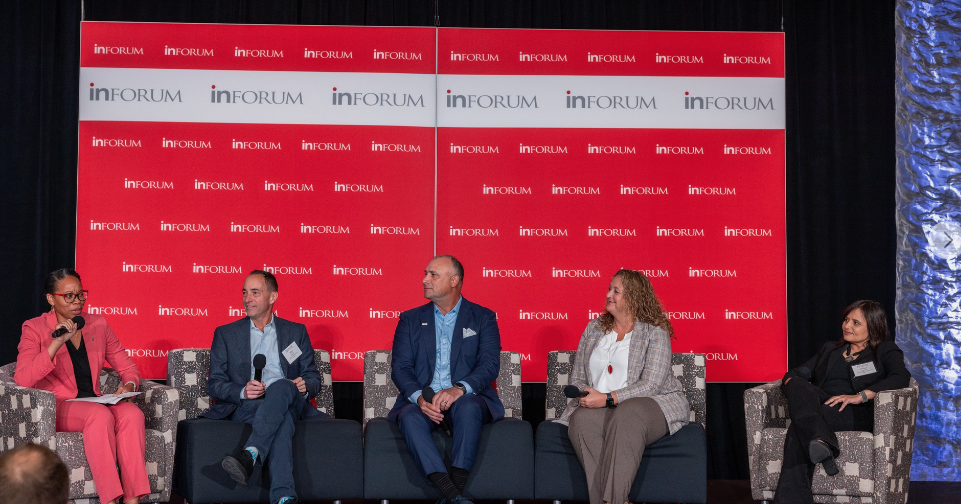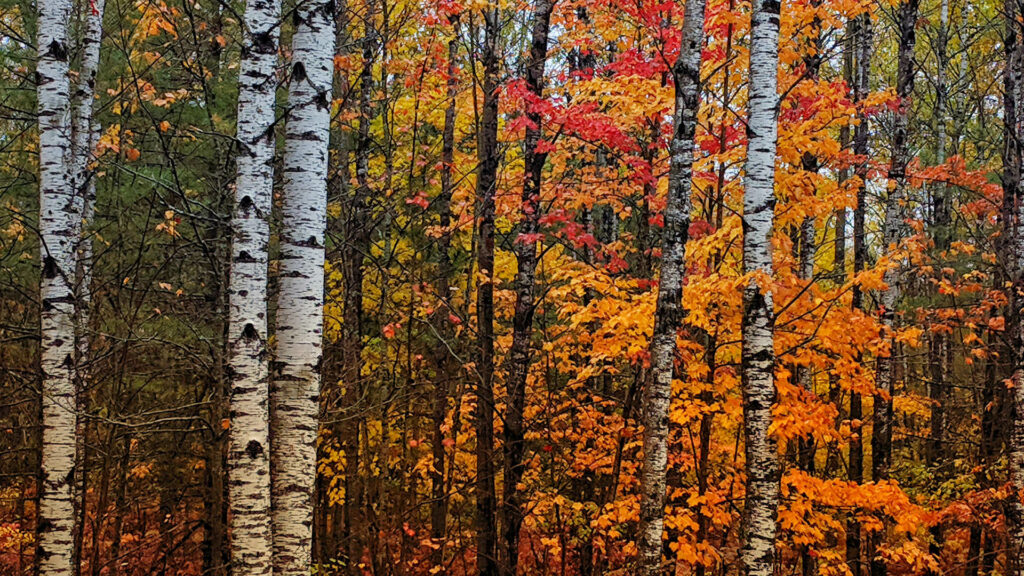Automotive Leaders Discuss Navigating the Shift to Mobility

Automotive always has been a technology-driven industry, but in the next ten years, there is likely to be more change in the industry than there has been in the last hundred. And much of that change will be taking place in Michigan. That shift – which moves automotive toward becoming a more sustainable industry – was the topic of a Sept. 15, 2023, breakfast, “Navigating the Shift to Mobility – With Detroit as a Leader,” hosted by Inforum, a nonprofit focused on accelerating women’s careers. The themes included diversity, new opportunities that come with and from young and emerging talent, the power of partnerships, and the future of mobility. Panelists were: Aruna Anand, President and CEO, Automotive Group Sector; head of architecture and networking, Continental North America Kristen Tabar, group vice president, Advanced Mobility Research & Development, Toyota North America Paul Thomas, president, Mobility in Americas, Bosch (effective Jan. 1, 2024), and Alan Wexler, senior vice president, strategy, and innovation, General Motors Justine Johnson, chief mobility officer for the State of Michigan, moderated the discussion. Our takeaways follow: Thomas: When you look for talent, look for talent that looks different from you. Different countries, beliefs, and perspectives, you have to look for talent that has diverse opinions on solutions. The world isn’t as simple as you think it is sometimes. Taber: When students look for a job, remember that it is not a one-and-done deal. You may think this is your passion and you work in this space, but what we see is that people evolve. That cross-pollination and common way to move throughout your career and experience different aspects of this new mobility solution. It’s a completely different landscape that requires different skill sets and backgrounds. Anand: We need to see ourselves in those positions that we are aspiring to be. If you do not have representation, then you don’t know what it’s like and you don’t have the confidence to do something because it is not done. We need to increase the pipeline. Then you understand the reasons why you can’t do this or what else you can do to fix it. Wexler: We see a world with zero crashes, zero emissions, zero congestion. Taber: It is about the products that we put out, how we operate our businesses, and the ripple effect on our supply chains. We need very clear, measurable methods so we are using similar yardsticks. Thomas: We want to invest in communities, we invest in Detroit and the Midwest very heavily to bring mobility people into our companies. We are also always on the diversity journey. You will never know when you are done because diversity is something that you always must work on. Anand: We tend to want to be perfect before we try new things. We find reasons to not be good at things. What is stopping us? We need that coaching, mentoring, role models, all of that together to build that pipeline better. Wexler: (Talent recruitment) really starts with the “why.” … We need skillsets from other industries. We’re becoming more technology-oriented … we pioneer the innovations that move and connect people to what matters, so it’s who wants to be part of that purpose and do something impactful. Taber: We have to understand that none of us is going to be able to move the technology forward by ourselves. It is going to take partnerships that we probably wouldn’t have thought of ever before. Anand: If we can provide an environment that is flexible, then the talents will be able to grow. Thomas: The ecosystem is so large and the opportunities to do different things are available to each one of you in the room. There is so much information out there on how to get involved in mobility. Wexler: There isn’t another industry that has the same opportunity to heal the planet. Experience the full event here. Be sure to subscribe to our newsletter for regular updates on sustainable business practices in and around Detroit.
Mitigating Climate Risks to Michigan’s Forestry Industry

More than half of Michigan is forested, with 20 million acres making up a vital part of the state’s landscape. Millions of acres of Michigan forest land are used to produce timber, a renewable and sustainably managed resource that supports many industries. The forests also provide other values, including wildlife habitat and watershed protection, and also help to sustain biodiversity. According to the Michigan Department of Natural Resources, the state’s forest products industries provide direct employment to almost 42,000 people, leading to $13.4 billion in economic output. Since 2014, jobs directly provided by forest products industries have increased by 9.7%. SBN Detroit spoke with DNR state forest planning and operations manager David Price about the impacts of climate change on Michigan forests, the trickle-down effect, and what can and is being done to mitigate risk. Q: How is climate change impacting forestry in Michigan? A: Forests have always been associated with Michigan. They’re a huge part of our social and economic fabric. Our forests support direct forestry jobs and also many other secondary industries. Trees are also important to our general well-being, mental health, and recreational pursuits. They help to regulate the global climate, absorbing a substantial portion of the fossil-fuel carbon emissions we humans produce. Climate change is driving concerns about forest health and productivity in many ways. Michigan is growing warmer and wetter, and there are projections that by the end of the century, the climate will be more like present Arkansas. Cold winters control and kill off certain insects that can be harmful to trees. Warmer winters mean these insects can be more persistent and harmful. Combine that with the fact that warmer weather can stress certain tree species and make them more susceptible to drought and less resistant to insects and disease, and we have a big problem. In Michigan, a good example of this is the hemlock woolly adelgid. We’ve been battling to contain this insect because it’s threatening to kill our hemlock trees along the coast of Lake Michigan. Cold winter weather helps to control the scale of this insect that spreads fungal disease, and warmer winters directly correlate to less winter mortality. There are operational considerations that climate change is causing as well. If the ground does not freeze, it’s significantly harder to harvest timber without causing extensive damage to the soils, potentially contributing to sediment moving into streams and wetlands. In Michigan, we have indigenous species such as red and jack pine, aspen, and boreal – spruces and firs – that are at the southern-most extent of their natural range in Michigan and they are not able to move quickly and adjust as the climate changes. A potential decline in the health and productivity of these tree species due to climate change will harm the values that they provide, including timber production, wildlife habitat, and carbon storage. An excellent example of this is the potential decline of jack pine forests in the northern Lower Peninsula which would cause a loss of habitat for the Kirtland’s warbler, a bird that is endemic to Michigan, recently removed from the endangered species list and proposed to be the new state bird of Michigan. So, as you can see, climate change is affecting our forest health and productivity in several ways. Q: What are the implications regarding business and the economy in Southeast Michigan? A: Michigan has a robust $22 billion forest-products industry. Most of the timber is harvested in northern Michigan, but secondary manufacturing occurs throughout the state, including Southeast Michigan. Many are surprised that Wayne County itself generates over a billion dollars in the forest products industry. The county’s paper products industry supports over 2,800 jobs alone. Think about sawmills in northern Michigan that then distribute products that are then sold at Menards, Home Depot, etc. This directly contributes to home construction in Southeast Michigan, which is also a huge industry. The bottom line is, maintaining a healthy and productive forest throughout the state is directly related to the economy in Southeast Michigan and the economy of the entire state. Q: What can be done to mitigate the risk to our forests, and what is the DNR doing about this? A: This is a million-dollar question. The happy news is that we can do things to change the outcome and the DNR has many initiatives in place. One simple thing we can do is plant trees. There is a lot of vacant land in northern Michigan that used to be forested. These areas are prime for reforestation. Planting trees is a great way to utilize nature for removing carbon from the atmosphere, and it’s underutilized in the state. The DNR plants over six million trees per year, most replacing forest that’s been harvested. The DNR has also initiated The Big Wild Forest Carbon Project, the first project in the nation to leverage the carbon storage capacity of trees on state forest lands. This pilot project captures carbon that is sequestered in trees and generated carbon credits. DTE Energy purchased the first decade of carbon offset credits to be used in their commercial natural gas programs. On a smaller scale, we are working offsetting power usage at our fish hatcheries through solar energy. We are also working with a company called Circle Power to develop two utility-scale solar energy projects on brownfield sites in the Upper and northern Lower Peninsulas. The DNR also partners with Michigan State University for some important research projects. First, we are evaluating assisted tree migration, which is a climate change adaptation strategy that involves moving trees or their genetic material from a known location to an area where they are presently well-adapted to an area where they are not currently present or prevalent, but where the trees may be better adapted to future climate under climate change projections. We are experimenting with new species and genetics of species and also identifying seed sources that may be better climate adapted to Michigan in the future to help the forest to


